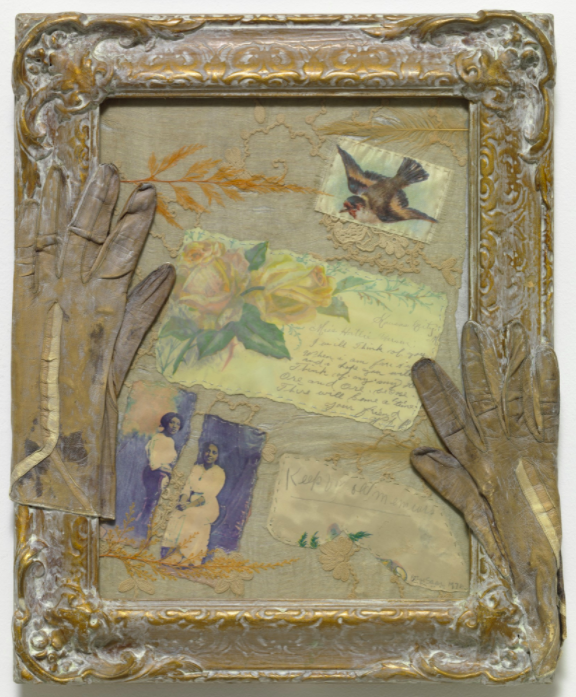Betye Saar
Betye Saar grew up in Los Angeles and Pasadena, California, and studied design at the University of California, Los Angeles — a career path frequently foisted upon women of color who were interested in the arts, due to racism and sexism prevalent in universities at the time. Saar eventually studied printmaking, and her earliest works are on paper. Using the soft-ground etching technique, she pressed stamps, stencils, and found materials into her plates to capture their images and textures.
Saar’s visit to an exhibition of work by Joseph Cornell at the Pasadena Art Museum in 1967 profoundly influenced her own artmaking. Cornell’s practice of collecting and arranging found objects into assemblage boxes inspired her to do the same. She began by inserting her own prints and drawings into window frames, as with Black Girl’s Window (1969), an iconic autobiographical work that also signaled a new interest in addressing race and contemporary events in her art.
Black Girl's Window, 1969. Wooden window frame with paint, cut-and-pasted printed and painted papers, daguerreotype, lenticular print, and plastic figurine, Gift of Candace King Weir through The Modern Women's Fund, and Committee on Painting and Sculpture Funds
After the assassination of Dr. Martin Luther King Jr., her mystical assemblages became increasingly radical. Saar has since repurposed washboards, jewelry boxes, and racist ephemera as a way of reclaiming images and artistic power. For her best-known work, The Liberation of Aunt Jemima (1972), Saar arms a Mammy caricature with a rifle and a hand grenade, rendering her a warrior against not only the physical violence imposed on black Americans but also the violence of derogatory stereotypes and imagery.
“My work started to become politicized after the death of Martin Luther King in 1968. But The Liberation of Aunt Jemima, which I made in 1972, was the first piece that was politically explicit. There was a community center in Berkeley, on the edge of Black Panther territory in Oakland, called the Rainbow Sign. They issued an open invitation to Black artists to be in a show about Black heroes, so I decided to make a Black heroine. For many years, I had collected derogatory images: postcards, a cigar-box label, an ad for beans, Darkie toothpaste. I found a little Aunt Jemima mammy figure, a caricature of a Black slave, like those later used to advertise pancakes. She had a broom in one hand and, on the other side, I gave her a rifle. In front of her, I placed a little postcard, of a mammy with a mulatto child, which is another way Black women were exploited during slavery. I used the derogatory image to empower the Black woman by making her a revolutionary like she was rebelling against her past enslavement. When my work was included in the exhibition ‘WACK! Art and the Feminist Revolution’, at the Museum of Contemporary Art in Los Angeles in 2007, the activist and academic Angela Davis gave a talk in which she said the Black women’s movement started with my work The Liberation of Aunt Jemima. That was a real thrill.”
The Liberation of Aunt Jemima, 1972. Berkeley Art Museum and Pacific Film Archive, Berkeley, California. Photo by Benjamin Blackwell. Courtesy of the artist and Roberts & Tilton, Los Angeles, California.
The intimacy and scale of Saar’s work encourages a personal connection to the artist and her experience. “To me, the trick is to seduce the viewer. If you can get the viewer to look at a work of art, then you might be able to give them some sort of message.” Over the course of her six-decade career, Saar has continued to make work that honors or critiques the familiar and mines the unknown. “It may not be possible to convey to someone else the mysterious transforming gifts by which dreams, memory, and experience become art. But I like to think that I can try.”
Saar continues to live and work in Los Angeles, working primarily in found object sculpture.
"Keep for Old Memiors," 1976. Pencil on paper, printed papers, and printed fabric sewn and pasted on fabric with lace, leaves, and feathers, mounted on painted frame with gloves. Gift of Jo Carole and Ronald S. Lauder.



